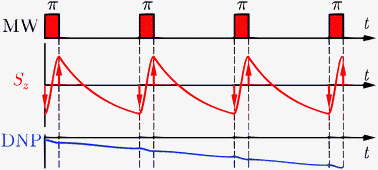Theory of the Overhauser effect in the pulsed mode of EPR pumping: exploiting the advantages of coherent electron spin motion
Abstract
A theoretical approach is proposed to describe Overhauser-type Dynamic Nuclear Polarization (DNP) for

* Corresponding authors
a
International Tomography Center SB RAS, Institutskaya 3a, Novosibirsk, Russia
E-mail:
ivanov@tomo.nsc.ru
Fax: +7(383)333-1399
Tel: +7(383)333-3861
b Novosibirsk State University, Pirogova 2, Novosibirsk, Russia
c
Free University of Berlin, Arnimallee 14, Berlin, Germany
E-mail:
hans-martin.vieth@physik.fu-berlin.de
Fax: +49(30)838-55081
Tel: +49(30)838-55062
A theoretical approach is proposed to describe Overhauser-type Dynamic Nuclear Polarization (DNP) for

 Please wait while we load your content...
Something went wrong. Try again?
Please wait while we load your content...
Something went wrong. Try again?
E. A. Nasibulov, K. L. Ivanov, A. V. Yurkovskaya and H. Vieth, Phys. Chem. Chem. Phys., 2012, 14, 6459 DOI: 10.1039/C2CP23896A
To request permission to reproduce material from this article, please go to the Copyright Clearance Center request page.
If you are an author contributing to an RSC publication, you do not need to request permission provided correct acknowledgement is given.
If you are the author of this article, you do not need to request permission to reproduce figures and diagrams provided correct acknowledgement is given. If you want to reproduce the whole article in a third-party publication (excluding your thesis/dissertation for which permission is not required) please go to the Copyright Clearance Center request page.
Read more about how to correctly acknowledge RSC content.
 Fetching data from CrossRef.
Fetching data from CrossRef.
This may take some time to load.
Loading related content
